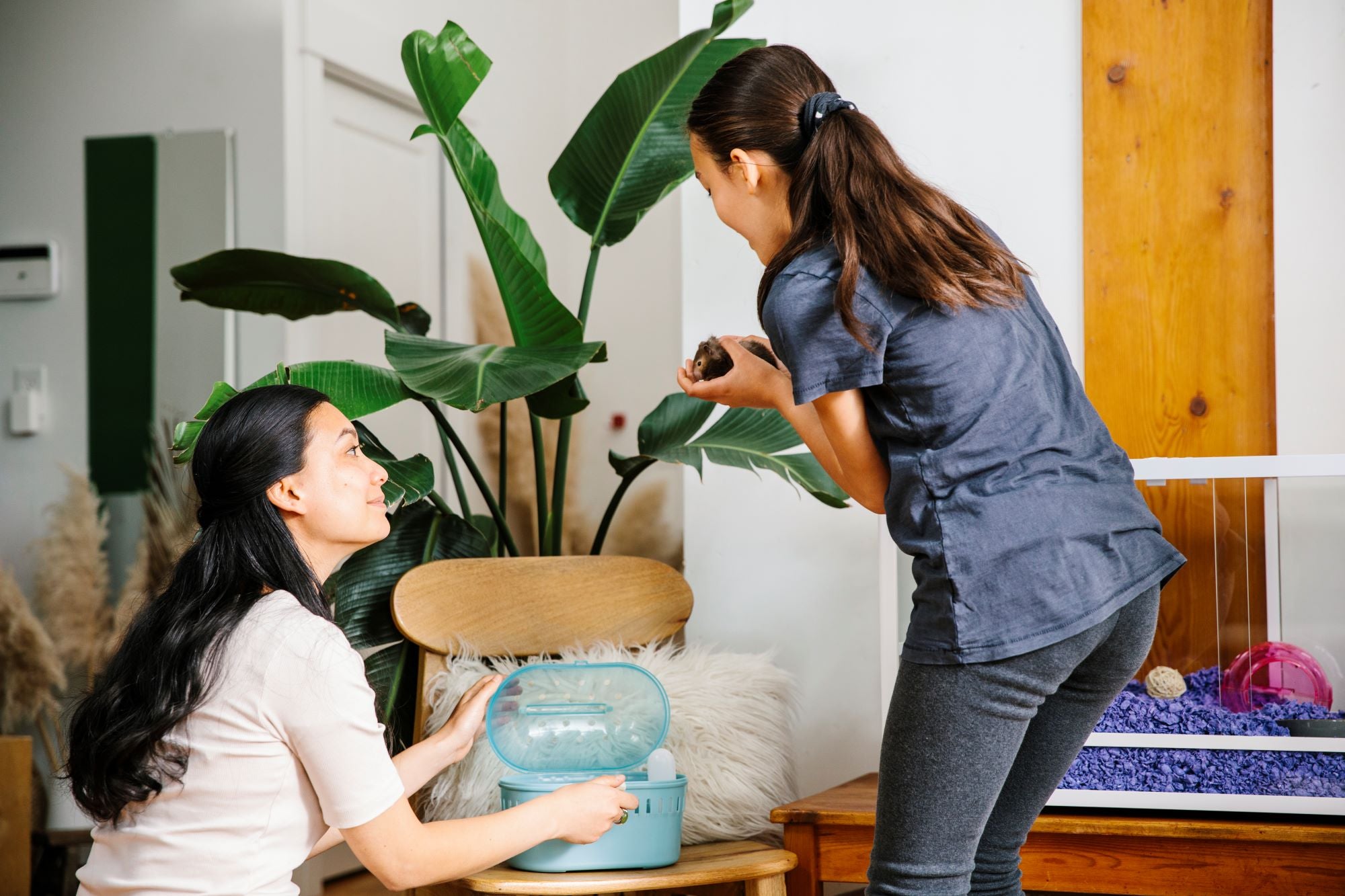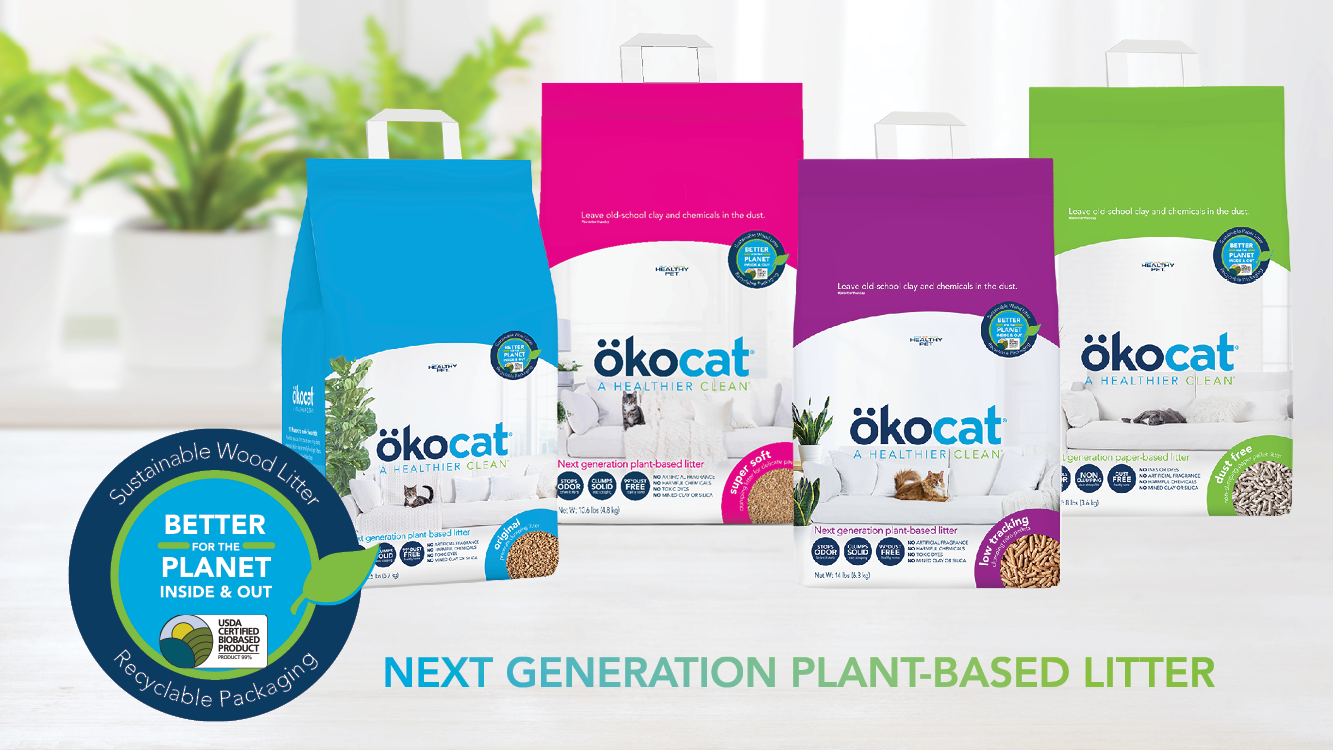ökocat® Expands Sustainable Lineup with New Multi-Cat Litter
FERNDALE, WASH. (October, 2025) – ökocat, the next generation of plant-based litter, today announced the debut of ökocat Multi-Cat, a new formula designed specifically for homes with more than one cat. The new Multi-Cat formula is the same great texture as the brand’s Original Premium litter, but introduces a naturally formulated, patented technology that delivers even stronger odor control. It effectively neutralizes urine, ammonia and fecal odors - without the use of added perfumes or artificial fragrances - leaving behind a natural, clean wood scent.“Building on the success of ökocat Original Premium litter, we’ve been wanting to introduce a multi-cat formula for some time,” said Healthy Pet Consumer Communications & Promotions Manager Leslie Ellis. “We conducted extensive research to develop a product that delivers powerful performance without compromising on our commitment to natural ingredients and sustainability.”ökocat Multi-Cat litter is available both online and in-store through retailers including Amazon, Chewy, Mud Bay and other independent pet retailers. It will be available in 2026 at even more locations as distribution and demand grows. To learn more about ökocat, purchase online or find a retailer near you, visit healthy-pet.com/okocat.
Read MoreThree Key New Hires for Healthy Pet in 2025
Mark Madison, Environmental Health and Safety (EHS) Supervisor
Mark Madison recently joined Healthy Pet as the new Environmental Health and Safety (EHS) Supervisor, with additional support responsibilities for Human Resources.
Mark brings over a decade of experience in workforce planning, safety operations, and HR leadership with a proven ability to build safer, more efficient, and people-centered workplaces. Most recently at Low Gravity LLC, he led comprehensive safety initiatives—including risk assessments, safety audits, and compliance training—resulting in measurable reductions in workplace incidents and enhanced operational readiness.
In addition to his safety expertise, Mark has deep experience in HR support functions, including employee relations, onboarding, succession planning, and engagement strategies—developed through leadership roles at Blue Apron and Fresh Realm as a Director of Workforce Planning Operations. His background in implementing Learning Management Systems, leading cross-functional teams, and managing compliance across multiple locations makes him uniquely equipped for this role.
Mark is also a certified trainer and has completed PMP certification prep, reflecting his commitment to continuous improvement and operational excellence.
Melissa Bishop, Plant Controller
Melissa Bishop has joined Healthy Pet as the new Plant Controller on the Finance team. Melissa brings 16 years of valuable automotive industry experience, with a strong background in finance and supply chain through her roles at Lear, Ventra, and International Automotive Components.
Melissa is truly a jack of all trades—beyond finance and supply chain, she has hands-on experience in operations, HR assistance, and maintenance planning to help fill any gaps. She is a dedicated team player, driven to exceed financial goals while supporting the entire team in achieving operational success.
Her core strengths include:
· Helping the team meet and exceed goals across all operational areas
· Continuous improvement mindset
· Accurate and transparent reporting
· Clear and open communication
Outside of work, Melissa enjoys kayaking and exploring nature. She’s a proud mom of a 23-year-old son and shares her home with a beloved “princess” cat. She’s also a big music fan who loves attending concerts.
Samaria Primus, QC Manager
Samaria Primus has joined Healthy Pet as the new QC Manager on the Quality team. With over 20 years of experience in food manufacturing, quality assurance, and regulatory compliance, Sam is a dedicated and results-driven leader committed to operational excellence.
She has overseen comprehensive QA operations, including equipment oversight, sanitation protocols, team development, and cross-functional collaboration. Sam brings a strong track record of leading successful HACCP and GMP programs, ensuring USDA compliance, and building robust QA systems that safeguard product integrity and consumer trust.
Her career includes leadership roles at organizations such as FreshRealm and Perdue Farms, where she consistently drove improvements in quality control, reporting efficiency, and team performance. Sam takes pride in mentoring staff, fostering a culture of accountability and continuous improvement, and aligning QA strategies with broader organizational goals. She thrives in dynamic environments and is passionate about leading high-performing teams that exceed industry standards.
Outside of work, Sam enjoys spending time outdoors, engaging in family activities, meeting new people, and trying new experiences. Whether it’s exploring nature, participating in community events, or discovering something unfamiliar, she values connection, growth, and living life with curiosity and purpose.
Read MoreNew Hires Announced for Healthy Pet Accounting Team, Ferndale, WA
We are excited to welcome Kate Neel and Ethan Marquardt as the newest members of the Healthy Pet Accounting Team. Kate joined us in March as a Payroll/AR Specialist and Ethan joined in April as an Accounts Payable Specialist. Both are working onsite in Ferndale, WA.
With a strong background in payroll processing and AR management, Kate brings attention to detail and a passion for keeping things running smoothly behind the scenes. Her skills and dedication help ensure our teams get the support they need. In this current role, Kate oversees payroll processing, manages accounts receivable functions, and supports financial operations to help streamline efficiency as the company continues to grow. Her strong background makes her an ideal fit for Healthy Pet's expanding team.
Kate was born and raised in Whatcom County, WA, and is proud to call Bellingham home. She holds a degree in Business Administration from Western Washington University and brings 17 years of experience in managing payroll and projects within the construction industry. Kate is also a proud mother to twin daughters, who are 9 years old, and a dedicated pet owner to two Hungarian hunting dogs, Oscar (4 years) and Pippi (5 months), as well as a Savannah cat named Obi.
Ethan joined us most recently and brings a solid background in public accounting and business management, a fantastic fit for this role. Ethan's experience has already proven valuable in quickly getting to know our accounting processes and ensuring accuracy in our day-to-day operations. Ethan is responsible for managing vendor payments, ensuring accuracy in financial documentation, and supporting the company's continued commitment to financial excellence and operational efficiency. With a keen eye for detail and a proactive mindset, Ethan is helping us keep things running smoothly as we continue to grow.
Ethan holds a degree in Finance from Western Washington University. Originally from Skagit County, he brings a well-rounded skill set and passion for continuous learning. Outside of work, Ethan enjoys indoor rock climbing, biking and attending hockey games.
These strategic hires underscore Healthy Pet's continued growth and dedication tohealthy pet building a high-performing Accounting & Finance team to support its expanding operations.
Read MoreHealthy Pet Welcomes Ephelius Cornelius as General Manager at Jesup, Georgia Facility
It has been over four months since Ephelius "EJ" Cornelious joined Healthy Pet as General Manager for our Jesup operations and what a great addition he has been. He brings an impressive background with experience from renowned organizations like Fresh Realm, Kraft Heinz, Tesla, and over 13 years of service in the U.S. Navy, where he served as an Enlisted Dental Tech on the USS Abraham Lincoln (CVN) and a a Surface Warfare Officer on the John Paul Jones (DDG).
EJ's focus at Healthy Pet encompasses planning, manufacturing, maintenance, and ensuring full compliance with company policies and procedures. Most notably, his leadership and expertise are vital as we continue to drive innovation and operational excellence.
Currently pursuing his Ph.D. in Strategic Leadership, which he expects to complete in 2026, EJ is enthusiastic about contributing to the Healthy Pet mission. When asked about joining our team, he shared:"I chose Healthy Pet because I believe this company is leading the way in innovation within the industry. I'm passionate about shaping a future where animals experience life free of chemicals and toxins. Beyond that, the people at Healthy Pet have stood out—caring, thoughtful, and genuinely amazing individuals who make this a truly special place to work."
EJ's leadership drives continuous improvement, fosters collaboration, and reinforces our commitment to delivering best-in-class products. His expertise and passion is a tremendous asset to our team. We're thrilled to have him on our team and appreciate all the great work he has already contributed.
Read Moreökocat®'s Latest Campaign Sheds Light on the Hazards of Clay and Silica Litter
FERNDALE, Wash., Sept. 24, 2024 /PRNewswire/ -- As a leader in the next generation of natural, plant-based litter, ökocat launched the first phase of a new campaign in May spelling out the harmful impacts traditional litters have on our homes, feline friends and the planet. The "Hidden Hazards of Clay and Silica Cat Litter" campaign was live across a number of platforms including streaming TV, YouTube, podcasts and social. The second phase is planned for early 2025.
"Inspired by our dedication to clean living and providing ultimate value through quality products, the new campaign underscores the health and environmental impacts of conventional litter," said Healthy Pet's Communications Manager Leslie Ellis. "We want to encourage others to join the movement towards a healthier, more sustainable future for both cats and the planet through products like ökocat that offer a safer, greener solution for our feline friends."
Clay and silica litter may pose serious health risks to cats. These litters also have significant negative impact on the environment, contributing to habitat destruction, air and water pollution and the depletion of natural resources. Alternatively, ökocat's natural and eco-friendly formulas are derived from virtually dust-free, biodegradable wood and paper waste, creating a safer environment for both cats and their families.
The campaign secured over 4 million impressions, raising awareness around the hazards associated with clay and silica litter and informing pet parents about associated health concerns.
For more information about ökocat, to purchase online or to find retail locations near you, visit healthy-pet.com/okocat.
Read MoreFilter - Key Words








 email us
email us